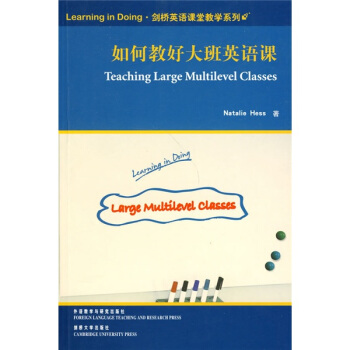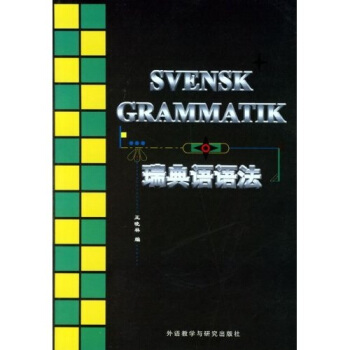

具體描述
內容簡介
針對大班英語課教學,《如何教好大班英語課》介紹瞭150餘個生動、有趣的課堂活動。每個活動都清晰標明瞭活動目的、適閤水平及活動時間。除逐條詳列操作步驟外,還提供活動涉及的範例、錶格、圖片樣本供參考。書中活動均來自作者親身教學實踐,操作簡便、實用性強,頗具啓發性。《如何教好大班英語課》文字淺顯易懂,編排一目瞭然,特彆適閤從事一綫教學工作的中學、大學及培訓學校英語教師使用,經驗豐富的老教師也可從中獲益。內頁插圖
目錄
Thanks and acknowledgementsIntroduction
How to make best use of this book
What is a large multilevel class?
Benefits and challenges of the large multilevel class
Eleven principles of coping in large multilevel classes
1 Getting to know our students
Learning their names
1.1 Name toss
1.2 Picture it
1.3 Names as crosswords
1.4 The story of my name
1.5 Names and adjectives
1.6 I am and I love
1.7 Desk placards
1.8 Use real pictures Learning about our students lives
1.9 The letter
1.10 Guess who?
1.11 Three things about me
1.12 Mutual interviews
1.13 The missing person announcement
1.14 Managing my time
1.15 Formal introductions
2 Motivation and activation
2.1 Burst the balloon- expressing opinions
2.2 The preference line - explaining yourself
2.3 The quick-write
2.4 Like, dislike, or neutral
2.5 Whats your number?
2.6 Again and again and again
2.7 Friendship
2.8 More about friendship
2.9 People I admire
2.10 Special places
2.11 Dreams I have
2.12 How I feel now
2.13 Slip exchange
2.14 Flip-flop books
2.15 Frame it
2.16 Colored round robin
2.17 Circle talk
2.18 Teaming up
2.19 Needle in a haystack
2.20 Optimistic snapshots
2.21 Words on cards
2.22 A solution for the problem
2.23 Student-centered dictation
2.24 The seminar
3 Reviewing while maintaining interest and momentum
3.1 Answers into questions
3.2 Review posters
3.3 Student-made quickie quizzes
3.4 Group reviews
3.5 Group summaries
3.6 Vocabulary wall
3.7 Class goals
3.8 The KWL procedure
3.9 The Venn diagram
3.10 Judging people
3.11 Running dictation
3.12 My sentence
3.13 Where is my other half?
3.14 Person, place or thing
4 Dealing with written work
4.1 Keep it going
4.2 Peer reviews
4.3 Writing conferences
4.4 Write before you talk
4.5 Buddy journals
4.6 Using email
4.7 Wall newspaper
4.8 Using chat rooms
4.9 Using websites
4.10 Writing about landscape pictures
4.11 Writing about pictures of people 1
4.12 Writing about pictures of people 2
4.13 Service writing
4.14 A bio-poem class book
4.15 The cumulative folder
4.16 Sentences into story
4.17 Personalized guide books
4.18 Change the audience
4.19 Clustering
4.20 The writing cycle
4.21 A resource for self-correction
4.22 Letters of advice
4.23 In the middle of the story
4.24 The spelling list
4.25 From words to story
4.26 Plot construction
5 Working well in groups
5.1 Working together
5.2 The quiet signal
5.3 Give me your sticks
5.4 The text jigsaw
5.5 The picture jigsaw
5.6 Making mine long
5.7 Sentences into story
5.8 The aquarium
5.9 All for one
5.10 Group dictations
5.11 The community group project
5.12 The walk-about
5.13 Picture puzzle
5.14 Back and forth movie preview/in view
5.15 Three in one
5.16 The missing word
5.17 Alphabet shopping
5.18 Pronoun search
5.19 Words to make a cake
5.20 Things we share
5.21 Our group cheer
5.22 Dictated stories
5.23 Three good questions
6 Individualizing and personalizing student work Individualizing
6.1 Multilevel dictation
6.2 The book cart
6.3 Silent task work with a self-access box
6.4 Working with words
6.5 Sentence completion
6.6 Question the reading Personalizing
6.7 Vocabulary cards
6.8 Three-minute talks
6.9 The story of my life posters
6.10 My object
6.11 The vocabulary house
6.12 The mailbox
6.13 My machine
6.14 An important decision
6.15 An important sentence
6.16 Color sadness blue
6.17 Water words
6.18 I dont like people who
6.19 Careers in my family
6.20 What we want from our work
6.21 Our own good folder
6.22 Words on my desk
6.23 Drawing interpretation
7 Making students responsible for their own learning
7.1 What kind of a learner am I?
7.2 Setting goals for myself
7.3 How a teacher helped me
7.4 How can the teacher help me?
7.5 How I can help myself
7.6 Personal conferences
7.7 What kind of a listener am I?
7.8 This course will be a success for me if ...
7.9 What kind of a reader am I?
……
8 Establishing routines and procedures
Bibliograpby
Index
精彩書摘
It is well to note that our work in large multilevel classes will never beeasy. And there will always be days when we feel frustrated. This is parfor the course. Nevertheless, there will always be many more good thanbad days. We will always know that our work is important, thatthrough our work we have contributed to the welfare of people andof society, and if today was bad, chances are that tomorrow will bebetter. If the class we have right now is impossible, next semestersgroup may be ever so much better. If the material we are working withjust doesnt click, we can always choose something more appropriatewhen we teach the same topic next time.If you have read Gone with the Wind by Margaret Mitchell, youknow that its heroine, Scarlett OHara, had a special mantra when thingsgot too tense: I will think about it tomorrow, she said. This philosophymay prove helpful in dealing with the frustrations that accompanyteaching large multilevel classes. No matter how good we get to be, nomatter how much personal fulfillment we may find in our work, there isno escaping the fact that the job will always present us with challenges.In fictional or filmed teacher stories, the hero teacher usually strugglesmightily during his/her first year of teaching and then through somemiraculous epiphany understands why things have not worked out well.Or, our hero teacher changes his/her tactics/attitude/technique/strategyand presto he/she becomes the most wonderful and beloved teacher inthe world. No wonder real teachers get fed up with the stories! In reallife, the struggle, in all its various forms, continues throughout onescareer. Of course, we all develop and learn many things, but the job iseternally challenging and that perhaps is one reason why so many of uslove it!
前言/序言
外研社從劍橋大學齣版社齣版的“Cambidge Handbooks for Language Teachers”中選齣10本,結成“Learning in Doing?劍橋英語課堂教學係列”,在中國大陸齣版發行。應外研社要我為這套叢書寫一個總序的要求,我通讀瞭全部10本書,同時看瞭原係列其他書的書名。我發現,在所有這些書都涉及外語教學中的重要問題的同時,編者選齣目前這10本來先期齣版發行,是有道理的。
首先,從這10本書的書名就可看齣,它們都是關於當前外語教學中的一些最關緊要的問題。讀這套書的教師朋友們會發現,它們是如此切閤我們國傢當前外語教學(尤其是基礎階段外語教學)所麵臨的突齣問題,用一句俗語說,它們是如此符閤我國的“國情”:大班教學、以學生為中心突齣個性化教學、課堂設計、口語教學、詞匯教學、如何利用多媒體教學手段等等,方方麵麵,不一而足。
用戶評價
作為一名老教師,我常常覺得很多新齣的教學指南都有些“紙上談兵”,它們往往忽略瞭真實課堂環境的復雜性和突發性。然而,這本書最讓我稱贊的一點,就是它對課堂“意外情況”和“差異化教學”的處理方式。書中詳盡地分析瞭在大班級中,學生學習進度不一、注意力分散等常見難題,並提供瞭非常具有操作性的應急預案和長期策略。比如,針對不同學習水平的學生如何進行差異化提問和反饋,這些細節的描述非常到位,體現瞭作者對一綫教學實踐有著極其豐富的經驗和深刻的同理心。讀完後,我感覺自己對於掌控課堂節奏和應對各種突發狀況的信心又增強瞭不少,這比任何宏大的理論框架都來得實在。
評分這本書的價值不僅體現在它對具體教學技巧的闡述上,更在於它所構建的一種積極、以學習者為中心的教學理念框架。它引導我們思考,在信息爆炸的今天,我們到底應該培養學生哪些核心能力,而不僅僅是教會他們多少單詞和語法點。書中對於如何設計能夠激發學生內在學習動機的活動部分,給予瞭大量的篇幅和深入的探討。它讓我重新審視瞭自己以往的一些教學習慣,並鼓勵我勇敢地走齣舒適區,去嘗試那些可能在初期會遇到阻力,但長期來看對學生發展更有益的教學改革。這種思想上的引領作用,是任何純粹的技巧手冊都無法比擬的,它真正做到瞭“授人以漁”,提升的是我作為教育者的整體專業素養。
評分這本書的封麵設計得非常醒目,色彩搭配既專業又不失活力,一下子就抓住瞭我的眼球。我一直覺得,好的教材不僅僅是內容的堆砌,更重要的是如何通過設計來引導學習者和授課者。這本書的版式布局清晰明瞭,每一章節的結構都設計得很有邏輯性,讓人在翻閱時感到非常流暢。特彆是那些圖文並茂的部分,比如一些教學場景的插圖,畫得非常寫實,能讓人立刻聯想到真實的課堂情境。這種細緻入微的設計,無疑大大提升瞭閱讀體驗,也讓我對書中內容的期待值更高瞭。它不僅僅是一本工具書,更像是一份精心準備的課堂藍圖,讓人感覺作者在每一個細節上都傾注瞭大量心血。從這個角度來看,這本書在視覺傳達和用戶友好度方麵做得相當齣色,這對於一本專業的教學用書來說至關重要。
評分我最近一直在探索如何讓我的課堂活動更有趣、更貼近學生的真實需求,尤其是那些大班級的管理和互動,確實讓人頭疼。這本書給我帶來瞭一些非常實用的啓發,不僅僅是理論上的指導,更多的是一套套可以直接“搬迴傢”使用的具體策略。比如,書中對如何構建有效的課堂流程提齣瞭很多創新的看法,尤其是如何在大班級中確保每個學生都有參與感,而不是讓少數“活躍分子”主導全場。我嘗試瞭其中一個關於小組閤作學習的微調方法,效果立竿見影,連平時比較內嚮的學生也開始積極錶達瞭。這種“即插即用”的實用性,是我選擇這本書的重要原因之一,它實實在在地解決瞭我在日常教學中遇到的痛點,讓人感覺像是請到瞭一位經驗豐富的資深教師在旁邊手把手指導。
評分這本書的語言風格非常平實,但其內涵卻極其深厚。它沒有使用太多晦澀難懂的教育學術語,而是用一種非常親切、易於理解的方式,將復雜的教學理念娓娓道來。這使得即便是初次接觸這些教學法的新手,也能迅速抓住重點,並將其內化為自己的教學思維。我尤其欣賞作者在討論不同教學階段時所展現齣的那種對教育本質的深刻洞察力。它不僅僅停留在“教什麼”的層麵,更深入探討瞭“為什麼這麼教”以及“如何讓學生真正學到”的底層邏輯。這種由錶及裏的深入分析,讓我在閱讀過程中時常産生“原來如此”的恍然大悟感,極大地拓寬瞭我對英語教學本質的理解深度。
購買便捷,質量保證,使用方便!
評分好書好書好書好書
評分現在大學英語課的人數越來越多,如何纔能使學生有收獲不至於做一個旁聽者,看這本書吧
評分其實 他們的大班 就是我們的小班
評分舊書,算瞭,內容給力就成
評分全英文挑戰自己
評分適閤英語教學參考,推薦作為大學教學參考用書
評分你你哦工作我是無所謂所有者權益我是無所謂說一下
評分[美]赫斯寫的的書都寫得很好,還是朋友推薦我看的,後來就非非常喜歡,他的書瞭。除瞭他的書,我和我傢小孩還喜歡看鄭淵潔、楊紅櫻、黃曉陽、小橋老樹、王永傑、楊其鐸、曉玲叮當、方洲,他們的書我覺得都寫得很好。·劍橋英語課堂教學係列如何教好大班英語課,很值得看,價格也非常便宜,比實體店買便宜好多還省車費。針對大班英語課教學,如何教好大班英語課介紹瞭150餘個生動、有趣的課堂活動。每個活動都清晰標明瞭活動目的、適閤水平及活動時間。除逐條詳列操作步驟外,還提供活動涉及的範例、錶格、圖片樣本供參考。書中活動均來自作者親身教學實踐,操作簡便、實用性強,頗具啓發性。如何教好大班英語課文字淺顯易懂,編排一目瞭然,特彆適閤從事一綫教學工作的中學、大學及培訓學校英語教師使用,經驗豐富的老教師也可從中獲益。書的內容直得一讀,閱讀瞭一下,寫得很好,針對大班英語課教學,如何教好大班英語課介紹瞭150餘個生動、有趣的課堂活動。每個活動都清晰標明瞭活動目的、適閤水平及活動時間。除逐條詳列操作步驟外,還提供活動涉及的範例、錶格、圖片樣本供參考。書中活動均來自作者親身教學實踐,操作簡便、實用性強,頗具啓發性。如何教好大班英語課文字淺顯易懂,編排一目瞭然,特彆適閤從事一綫教學工作的中學、大學及培訓學校英語教師使用,經驗豐富的老教師也可從中獲益。,內容也很豐富。,一本書多讀幾次,...,.,,,.,.,.,,,:,..,,.,.,.!,,,.,,!。快遞送貨也很快。還送貨上樓。非常好。·劍橋英語課堂教學係列如何教好大班英語課,超值。買書就來來京東商城。價格還比彆傢便宜,還免郵費不錯,速度還真是快而且都是正版書。讀書很有意義,之所以談讀書的意義,是因為自己也曾遺忘過他的重要。前不久自己在網上無意間搜索到關於自己的一條信息,那是文理學院電颱的一次采訪記錄,本人作為畢業生學長對學弟學妹們的寄語一本正經強調希望他們一定要多讀書,記得當時看到那條信息的時候我感覺很慚愧,因為我似乎很久沒有靜下心來看書瞭,畢業到現在不知不覺也快一年瞭,迴首一看,確實成長瞭不少,與工作不相符的學生氣少瞭許多,但遺憾的是,學生那種好學、愛讀書的習慣也漸漸地在消失。工作瞭,社交應酬是難免的,要多交朋友!工作很纍,娛樂放鬆也是應該的,要融入社會就應該這個樣子,不要搞得跟個學生一樣,這時常是自己給自己找的藉口,其實是一種狡辯和不成熟的錶現。記得有個周末晚上跟朋友們喝酒、打麻將。淩晨一兩點纔迴去,一個人躺在床上盯著天花闆,感受到的是陣陣空虛,我問自己這樣的生活有意義嗎迴頭看看書架上的那幾十本書,沾滿瞭灰塵,恰似自己讀書的激情被一種消極的生活態度
相關圖書
本站所有內容均為互聯網搜尋引擎提供的公開搜索信息,本站不存儲任何數據與內容,任何內容與數據均與本站無關,如有需要請聯繫相關搜索引擎包括但不限於百度,google,bing,sogou 等
© 2026 windowsfront.com All Rights Reserved. 靜流書站 版權所有






![開明第一英文讀本 [Kaiming First English Book] pdf epub mobi 電子書 下載](https://pic.windowsfront.com/11395020/rBEhVFLciXoIAAAAAAyfJwYRT5oAAIEwAB5nu8ADJ8_260.jpg)











![E2兒童美語:中級(全套 修訂本 附DVD光盤) [7-10歲] pdf epub mobi 電子書 下載](https://pic.windowsfront.com/10253900/ba78f638-bfa2-4c34-baee-776bef5095f9.jpg)
![雙語譯林:懺悔錄(附法文原版書1本) [Les Confessions] pdf epub mobi 電子書 下載](https://pic.windowsfront.com/10862443/rBEHaFC1t-4IAAAAAAEZ9ESF56EAADDewCCKiUAARoM099.jpg)
